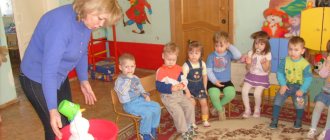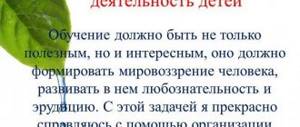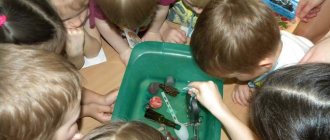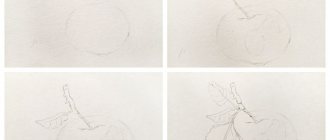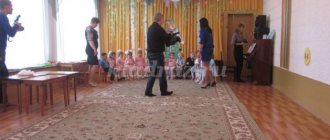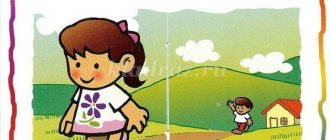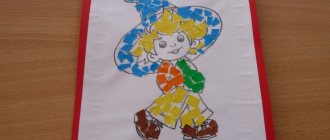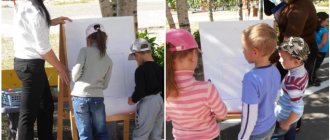Experimental lesson in the second junior group
In the second younger group, a lesson within the framework of experimental activities is structured taking into account the age characteristics of children 3–4 years old and, according to SANPiN standards, lasts no more than 15 minutes. The structure of the lesson combines various forms to prevent overwork in students and maintain a positive attitude: entertaining, active and didactic games, physical education and finger exercises, educational and didactic conversations, learning rhymes, solving riddles, listening to musical fragments and singing songs, looking at illustrative materials .
Experience is the teacher of everything.
Julius Caesar
Motivating start to class
Children 3–4 years old concentrate their attention on phenomena and objects that interest them and evoke positive emotions. To create an incentive to experiment and search for answers to the questions posed, the teacher organizes the beginning of a motivating lesson. Younger preschoolers love to watch experiments, just as they love to watch performances and theatrical scenes. It often happens that the practical side evokes such vivid positive emotions in children that they lose the joy of discovery itself, which is what every experiment strives for.
The motivating beginning of the lesson should not only contain an entertaining element, but also encourage the solution of any problem situation and evoke a desire to find out the significance of the research conducted. For these purposes, visual material is used (posters, cards and postcards, illustrations of books, encyclopedias, slide demonstrations, videos), outdoor and didactic games, thematic gymnastics or exercises are organized, educational conversations are held in which students are given the opportunity to give examples from personal experience, fairy-tale characters and puppet theater heroes are invited to participate.
The emotional mood of students at the beginning of the lesson largely influences the final result of the event.
Table: examples of motivating start to classes
| Lesson topic | Motivating start |
| "Muddy Water" | Involving a fairy-tale character and creating a problematic situation. Vasilisa the Beautiful comes to visit the guys. She's sad. The guys ask what is the reason for her sadness. Vasilisa says that in the Far Far Away Kingdom there is a beautiful lake, the water in it was always so clean and transparent that you could see the bottom. On the demonstration table there is a container made of transparent plastic or a glass aquarium with water, at the bottom of which there is sand, pebbles and shells. Vasilisa says that yesterday Muka got naughty in the kingdom, ran and frolicked on the shore of the lake, tripped and woke up in the pond. The heroine invites the children to pour flour from cups into the aquarium. The water becomes white and opaque. That is why Vasilisa is sad that now the lake water has become cloudy, and there is no way to catch flour from the lake (she invites the children to try to do this with the help of nets). The fairy-tale heroine asks to find the answer to how the water can become transparent again. This is followed by the active game “We sat on the golden porch,” after which the children observe how the state of the water in the aquarium has changed (it becomes clearer because the flour settles to the bottom). |
| "Clean hands" | The use of Moidodyr dolls and toys, game elements, and the use of literary texts. The doll Natasha greets the guys. The teacher notices that her hands are dirty, but the doll denies this and claims that she just got tanned in the sun. Moidodyr appears. The teacher reads an excerpt from K. Chukovsky’s work “Oh, you’re disgusting, oh, you’re dirty.” The teacher asks the doll if she knows this character (she doesn’t know), asks the guys (they call him Moidodyr). In the conversation, the children remember what happened to the sloppy boy and how he eventually became friends with the washbasin. The teacher shows the doll and the children that transparent containers with clean water are prepared on the demonstration table and invites the children to experimentally prove to Natasha that her hands are not tanned, but dirty. There should be a discussion on how to do this (in one container, rinse the children’s clean hands, and in another, wash the doll’s hands; if the hands are dirty, the water will become cloudy). |
| "Ice Decorations" | Studying visual material, posing a problem problem. At the beginning of the lesson, the children are invited to look at photographs (or book illustrations) of New Year trees. The teacher asks questions:
The teacher takes the children to the window, shows the artificial Christmas tree installed on the playground of their group, and reports that the head asked them to decorate the Christmas tree for the New Year and gave them a box of materials for this. The guys open the box and find various shaped molds, paints, brushes and ribbons in it. The teacher asks how to make Christmas tree decorations using these things (fill the molds with water, add paints, make loops from ribbons and freeze them - the ice figures won’t melt outside). |
As a result of experimenting with freezing colored water in molds, the children receive ice decorations with which they can decorate the Christmas tree on the territory of the preschool educational institution
Lesson time plan
The experimentation lesson has a rough plan:
- organizational moment - 1 minute;
- motivating start of the lesson - 3-4 minutes;
- play or physical activity - 4–5 minutes;
- practical activity - 4–6 minutes;
- summing up, reflection - 1 minute.
After conducting the experiments, the children are given simple work assignments: tidy up the workplace, clean the surface of the demonstration table, help the teacher wash the tools or put the devices back in place. At the end of the lesson, the teacher invites the children to share the emotions they experienced:
- Did you enjoy the activity?
- What was the most interesting thing?
- Would you like to repeat the experiment yourself and tell your parents about it at home?
- Would you be interested in continuing to study the properties of the object we experimented with today?
Activity during classes and curiosity of students are always encouraged
Table: card index of experiences and experiments
| Subjects | Contents of experiments and tests |
| "Liquid form of water" |
|
| "Solid form of water: ice and snow" |
|
| "Sand" |
|
| "Air" |
|
| "Objects of the plant world" |
|
| "Fabrics" | Experimenting with different types of fabrics to determine their properties: ability to absorb water, wrinkles or not, durable or torn. |
| "Light and shadow" |
|
| "Magnet" | Experimenting with magnets and metal objects (familiarity with safety precautions is required for these experiments). |
| "Experiments-tricks" | In the second younger group, these experiments are demonstrated by the teacher, some of them can be repeated after viewing by the pupils, subject to safety precautions and under the supervision of an adult.
|
Children begin to study the properties of air while experimenting with soap bubbles.
Table: example of a summary of experimental activities in the second junior group (fragment)
| Author | Lodorkina V.N., teacher at MBDOU D/s “Kolobok”, Aksubaevo village, Republic of Tatarstan. |
| Name | "Magic Peas" |
| Target | Creating a social development situation in the process of organizing cognitive and research activities through communication and play. |
| Tasks |
|
| Materials |
|
| Organizational stage | V.: Today we will go to a fairy tale. (Showing a fairy tale - presentation). Grandmother and Cockerel lived in a small hut at the edge of the forest. Grandmother instructed Cockerel to complete the task - to sort the peas from the beans and wash the peas. The cockerel immediately decided to complete the task. But a friend came to him, they began to play, and our Cockerel forgot about the task. The friend left. (A rooster is heard crowing). Q: Guys, why do you think the cockerel crows? What task did Grandma assign to Cockerel? (Sort the peas from the beans and wash the peas). Shall we help Cockerel? (Children's answers). |
| Main part | V.: Come to the table, guys, listen to the task carefully. You need to sort out the cereal from a large cup: put the peas in one plate, and the beans in another. Begin. (Children separate the peas and beans on their own.) Q: Have you chosen everything? What's in this plate and what's in this one? (Children's answers). What do peas look like? Are beans similar to peas? Pour beans into my plate! Well done, we were able to separate the peas from the beans. Take some cups of peas and come with me. What did grandma ask you to do with the peas? (Wash). Now we will wash the peas. Pour the peas into your glass of water. Children and the teacher conduct an experiment: they lower one end of the tube into a glass and quietly blow into it, the peas slowly dance. Then they blow harder into the tube, the peas dance faster. <…> Speech exercise (children perform movements to music). V.: Now let’s go to the table. The cockerel has prepared a surprise for you, but he hid it in the peas. Dip your hand into the peas and look for a surprise. (Children are looking for a surprise in the peas). |
| Final part | Q: Guys, what good deed did we do today, who did we help today? (Children's answers). It turns out that good deeds need to be done constantly. Well done to you and me, let's give ourselves a round of applause. |
| Quote from: https://portal2011.com/konspekt-zanyatiya-opytno-eksperimentalnaya-deyatelnost-vo/ | |
Open lesson
Open experimental classes are conducted to demonstrate the skills acquired by younger preschoolers during their education in kindergarten. In a playful way, children solve non-standard problems, discuss problematic situations, observe and draw conclusions.
Open lesson “Hard - soft”
Purpose: to distinguish the qualities of objects.
Tasks:
- Give an idea of the properties of objects.
- Stimulate observation and logic.
- Develop tactile sensations.
- Enrich the vocabulary (hard, strong, white, light).
Materials and equipment:
- small stones;
- cotton wool;
- water;
- spoon.
Progress of the lesson:
- The teacher reads a letter from three little pigs, in which they ask what material they should use to build houses (cotton wool or stones). It is proposed to conduct an experiment and find out.
- Experiments are being carried out. Take the stones, touch them, crush them, squeeze them in your palms, try to break them into pieces - it doesn’t work (conclusion: the stone is hard, strong). Trying to blow the pebble off the table doesn’t work (conclusion: it’s heavy). Take cotton wool and do the same with it (conclusion: the cotton wool is soft, airy, light). Take a plate with water, lower the stone and cotton wool one by one (conclusion: the stone does not get wet, the cotton wool becomes wet).
- The conclusion is voiced: the house must be built from stones.
- Knowledge of the properties of objects is consolidated: put your hand in the hat, touch the object, describe it by touch.
Card index of didactic games in mathematics for the second junior groups
Important. The result of research work with children will be a system of didactic materials, albums and tables, which will reflect the main points of the experiments and conclusions drawn together with the kids.
Design of an experimentation center in the second junior group of a preschool educational institution
A well-organized subject-spatial environment in a group by the teacher allows children to develop research skills and attempt independent experimentation. An experimentation center is being created in the group’s premises; for the functioning of the experimental activity circle, a separate room is allocated for a mini-laboratory. Equipment and materials for practical research are stored in symbolically marked cabinets or drawers. The experimentation center provides space for thematic exhibitions (for Ecology Week, Water Festival, Winter Festival, etc.) and a stand for demonstrating the activities of the children: wall newspapers, final design works, photo collages, etc. are placed here.
For pupils of the second junior group, it is recommended to create a sand and water center - an area for experimenting and playing with these substances. Child psychologists note the beneficial effects of activities with water and sand on the emotional state of children: the balance of internal forces is restored, symptoms of overwork are relieved, negative emotions are replaced by a positive attitude.
It is advisable that the center of sand and water be in close proximity to the washroom
Material base of the experimental center:
- natural materials: sand, stones, wood samples, leaves, grains, shells;
- other materials: fabric samples, paper;
- toys for research: balls, cubes, small objects made of different materials;
- equipment: magnets, colored and magnifying lenses, mirror, rulers, scales;
- vessels: glasses, bowls, jars, beakers, flasks;
- medical materials: tweezers, cotton pads and swabs, gauze;
- substances: salt, sugar, food coloring, flour, soap bubbles;
- aprons, scarves, sleeves.
Unstructured materials are kept out of the reach of children. Bulk substances (sugar, sand, salt), dyes, small objects (pebbles, seeds, accessories, etc.) are potentially dangerous for small children, since if used and handled incorrectly they can enter the respiratory tract. The teacher introduces the children to them, demonstrates acceptable research options, and voices safety rules when experimenting with these objects. Pupils carry out practical activities under the supervision of a teacher.
Photo gallery: examples of design of experimentation centers
All materials and instruments in the research center are available to students under the supervision of a teacher
Boxes with materials for conducting experiments by younger preschoolers are indicated using pictures-symbols
The Experimentation Center can be given a funny name
Experiments with water and sand develop children's fine motor skills and restore emotional balance.
The center of experimentation should contain both materials for conducting simple experiments and objects for experimental games
The presence of funny pictures and signs attracts the interest of younger preschoolers to the corner
Collections of various materials for study (fabrics, minerals, shells) are stored in the experimental activity corner.
For pupils of the second junior group, the corner is decorated with mnemonic tables with safety rules
For pupils of younger groups, a bright owner toy is placed in the corner
The experimental activity center for children 3–4 years old includes kits for conducting experimental games
If space allows, students’ crafts can be placed in the experimentation center
